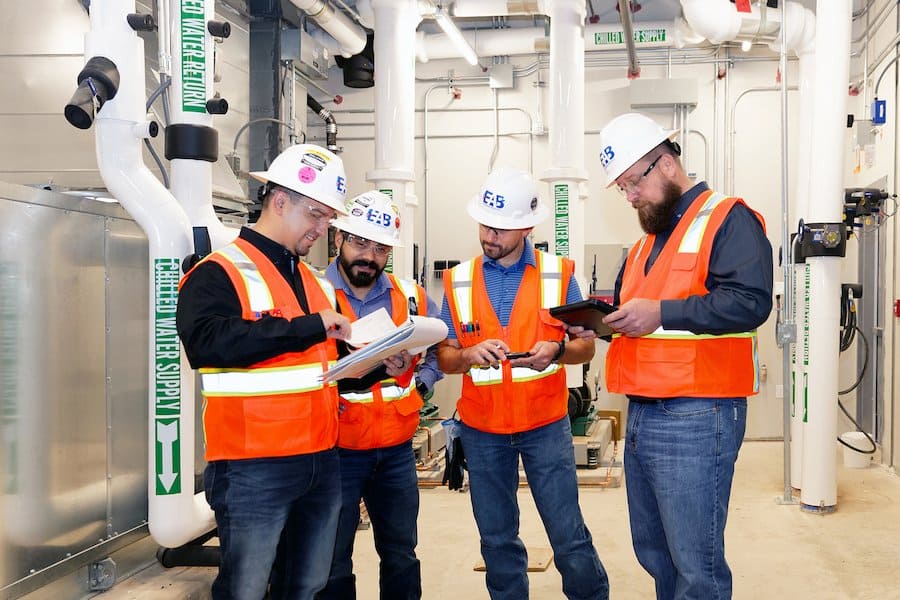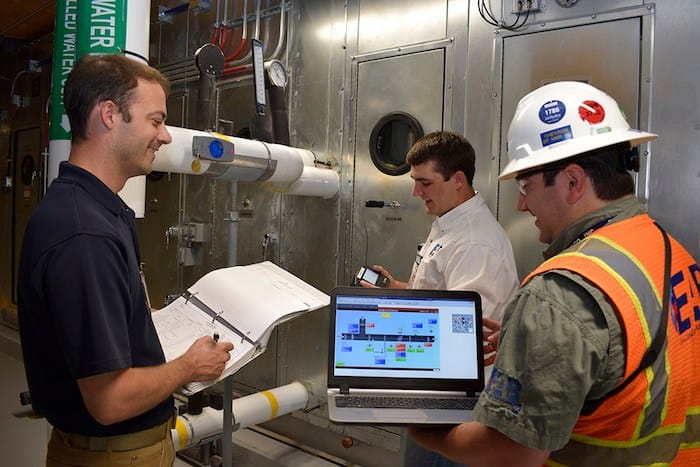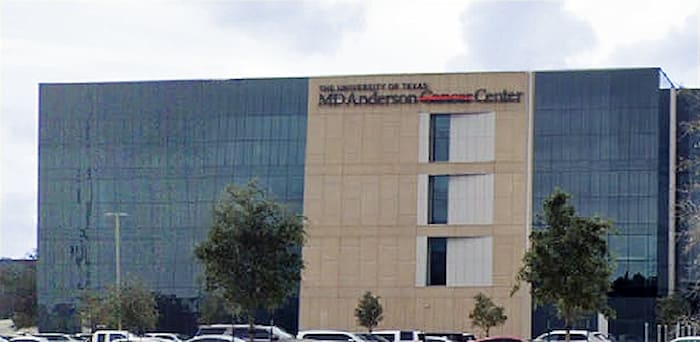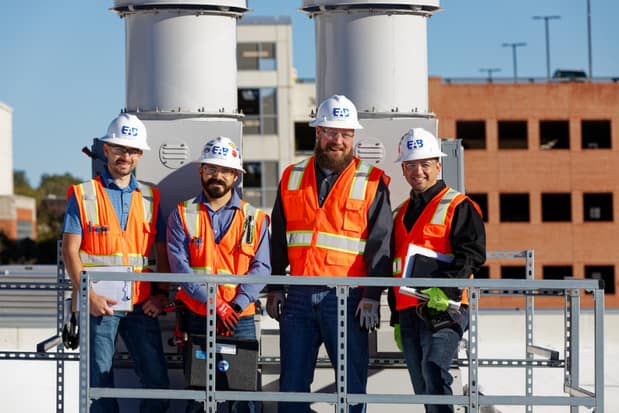
What can you do to ensure a complex building operates efficiently and reliably from day one? The answer lies in a carefully crafted commissioning plan. This foundational document guides the commissioning process, ensuring that all systems in a building are tested, verified, and optimized to meet performance standards and regulatory requirements. A successful commissioning plan is essential for achieving energy efficiency, seamless system integration, and long-term operational reliability.
This article will explore the critical elements of a successful commissioning plan, explaining its role in delivering high-performing buildings. We’ll also highlight the MD Anderson West Houston project as a case study to illustrate how Engineered Air Balance (EAB) implemented a comprehensive commissioning plan to create a reliable healthcare facility.
What is a Commissioning Plan?
A commissioning plan is a detailed roadmap that outlines the goals, processes, and responsibilities of the commissioning team. It ensures that mechanical, electrical, plumbing (MEP), and life safety systems operate according to design specifications, meet regulatory requirements, and support the owner’s project requirements (OPR).
By providing a structured framework, a commissioning plan fosters collaboration among stakeholders, minimizes project risks, and ensures efficient building operations from the start.
Key Elements of a Successful Commissioning Plan
A successful commissioning plan includes several critical components that guide the process from design to post-occupancy:
1. Design Review
The commissioning process begins with a thorough review of the design documents to ensure alignment with the project’s goals. This step is crucial for identifying potential issues early and making adjustments before construction begins.
- Verify Alignment with OPR: Confirm that the design reflects the owner’s requirements for performance, energy efficiency, and sustainability.
- Identify Potential Challenges: Highlight design flaws or coordination gaps that could lead to inefficiencies or operational issues.
2. System Verification
During construction, the commissioning team verifies that all systems are installed correctly and in compliance with design specifications. This phase ensures that the foundation for successful testing and operation is in place.
- Inspect Equipment Installation: Verify that all components, such as HVAC units, electrical panels, and plumbing fixtures, are installed as designed.
- Review Submittals and Documentation: Cross-check equipment specifications, installation manuals, and contractor submittals for accuracy.
System verification reduces the risk of delays and ensures that systems are ready for functional performance testing.
3. Functional Performance Testing
Functional performance testing is the cornerstone of the commissioning process. This phase evaluates whether individual systems and integrated building systems operate as intended under real-world conditions.
- Simulate Operational Scenarios: Test systems during normal operation, peak loads, and emergencies.
- Verify Performance Metrics: Measure energy consumption, airflow rates, temperature control, and response times to ensure compliance with design specifications.
- Address Deficiencies: Identify and resolve issues such as sensor calibration errors or improper system configurations.
For the MD Anderson West Houston project, functional testing played a vital role in ensuring that HVAC and life safety systems operated efficiently and reliably, even under high-demand scenarios.
4. System Integration Testing
In modern buildings, multiple systems must work together seamlessly to ensure optimal performance. System integration testing evaluates how well mechanical, electrical, plumbing, and life safety systems interact.
- HVAC and Building Automation: Confirm that HVAC systems communicate effectively with the building automation system (BAS) for precise control and monitoring.
- Life Safety Systems: Verify that emergency systems, such as fire alarms and smoke control, operate correctly during power outages or emergencies.
5. Stakeholder Collaboration
A successful commissioning plan depends on clear communication and collaboration among all stakeholders, including owners, contractors, engineers, and commissioning providers.
- Define Roles and Responsibilities: Specify who is responsible for each phase of the commissioning process.
- Hold Regular Meetings: Ensure stakeholders are aligned on goals, progress, and any issues that need resolution.
Stakeholder collaboration was a key factor in the success of the MD Anderson West Houston project. EAB worked closely with contractors and facility operators to ensure that all systems met healthcare industry standards.
6. Clear Documentation
Accurate and detailed documentation is essential for maintaining transparency and accountability throughout the commissioning process.
- Commissioning Plan: A comprehensive document outlining the scope, processes, and testing procedures.
- Testing Logs and Reports: Detailed records of functional testing, integration testing, and issue resolution.
- O&M Manuals: Documentation to guide operations and maintenance staff in managing the building’s systems.
7. Post-Occupancy Support
Commissioning doesn’t end when construction is complete. Post-occupancy support ensures that systems continue to perform as intended over time.
- Performance Monitoring: Review system performance data and address any operational issues.
- Training and Handover: Provide training for facility staff to operate and maintain building systems effectively.
- Warranty Period Support: Resolve any issues that arise during the warranty period to maintain optimal performance.
Benefits of a Comprehensive Commissioning Plan
A well-developed commissioning plan delivers significant benefits for building owners and operators:
1. Optimized System Performance
Commissioning ensures that systems operate efficiently, reducing energy consumption and operational costs.
2. Improved Occupant Comfort
Properly commissioned systems provide consistent temperature, air quality, and lighting, enhancing occupant satisfaction.
3. Reduced Risks and Downtime
By identifying and addressing potential issues early, commissioning minimizes the risk of system failures or operational disruptions.
4. Regulatory Compliance
Commissioning ensures systems meet building codes, industry standards, and sustainability certifications, such as LEED.
5. Long-Term Reliability
Comprehensive testing and documentation provide a solid foundation for ongoing maintenance and long-term system reliability.
Case Study: The University of Texas MD Anderson Cancer Center West Houston
The MD Anderson West Houston project showcases how EAB’s commissioning plan ensured the smooth operation of a high-performing healthcare facility.
Project Overview
MD Anderson West Houston required a state-of-the-art facility to support its mission of providing world-class cancer treatment. The project involved complex building systems, including advanced HVAC and life safety systems, that are needed to meet stringent healthcare standards.
Challenges
- System Complexity: The facility’s advanced systems required seamless integration for efficient operation.
- Regulatory Compliance: All systems had to comply with healthcare industry regulations.
- Reliability and Redundancy: The building required robust systems to ensure uninterrupted operation during emergencies.
EAB’s Role
Engineered Air Balance (EAB) played a critical role in the project by implementing a comprehensive commissioning plan:
- Design Review: Evaluated design documents to optimize system performance and ensure compliance with healthcare standards.
- System Verification: Verified the installation of HVAC, electrical, and life safety systems to ensure they met design specifications.
- Functional Testing: Conducted rigorous testing of HVAC systems to ensure consistent temperature and air quality.
- System Integration: Validated seamless communication between HVAC, life safety, and BAS systems.
- Documentation and Training: Provided with detailed documentation and trained facility staff on system operation and maintenance.
Results
- Enhanced Performance: Systems operated reliably and efficiently, supporting the hospital’s mission of delivering exceptional patient care.
- Regulatory Compliance: All systems met healthcare industry standards, ensuring safety and accreditation.
- Long-Term Reliability: EAB’s commissioning efforts provided a strong foundation for the facility’s ongoing success.
Invest in a Successful Commissioning Plan
A successful commissioning plan is the cornerstone of efficient and reliable building operations. By guiding the process from design to post-occupancy, a commissioning plan ensures that systems meet performance standards, regulatory requirements, and operational goals.
The MD Anderson West Houston project exemplifies the value of a comprehensive commissioning plan, demonstrating how EAB’s expertise delivered a high-performing healthcare facility.
If you’re planning a complex building project, trust Engineered Air Balance (EAB) to provide the expertise and precision needed to develop and execute a successful commissioning plan. Contact us today to learn more about our services and how we can help optimize your building’s performance. Let’s ensure your project achieves its full potential.





